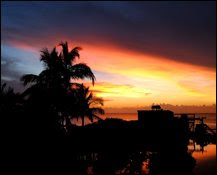 Mangrove Solutions Division:Dr. Catherine Jadot - president
Mangrove Solutions Division:Dr. Catherine Jadot - presidentBen Chisholm - project coordinator
http://www.mangrovesolutions.com
We are exploring yet another technique for planting mangroves out beyond the protection of the rip-rap. The Mangroves Solution Division is using KML as a beta test site here in the Keys.
The project:To stabilize the seedlings (propagules) in the ocean, one proven method uses split encasement tubes driven into the sediment. This method protects against the wrack line, however, it doesn't alone promote the optimal growth of the seedling. A solution combining this wrack protection and Reef Ball technology has been developed to ensure the fastest, healthiest, and most protected growth of the mangrove tree. This solution is ideal for numerous applications including erosion efforts, enhancing aesthetical aspects of property and fertilizer runoff filtration.
 Anchoring
Anchoring in high energy areas:
Suitable anchoring of the propagule is a common problem encountered. The Reef Ball Mangrove Planting Solution provides a steel anchor allowing a durable mooring.
Foundation Protection - Armored Cultivator Pot:
The concrete base of the device allows the propagule & roots to be protected from submerged debris. Available in a bio-degradable version, the solution has the ability to “wash away” as the mangrove matures and no longer needs assistance, leaving only a self sufficient, beautiful mangrove.
Wrack Protection - split PVC pipe:
Armored Cultivator Pot's stems will be shielded from waves, floating debris, wind, upland runoff, predation and UV, avoiding the troubles that most often cause plant failures in high energy zones
Enriched environment - fertilizer disk:
The Reef Ball Solution includes slow release fertilizer nutrients to optimize mangrove growth.
Putting it all together:
Mangrove propagules from the mangroves already on site were collected. The metal anchors were pounded into the hardbottom. The PVC wrack protectors were pounded over the stake. The armored cultivator pots were packed with peat and the bottom "sealed" with a fertilizer disk, then slid over the PVC pipe and stomped firmly into the muck on the bottom. The PVC pipes were filled with more peat to the mean high tide level and a propagule was dropped into the tube.
 12 new mangroves planted at KML!
12 new mangroves planted at KML!We will be watching for them to poke their noses out of the rack protectors in the next couple months as the reach for they sun.


mangroves in armored pots at low tide














